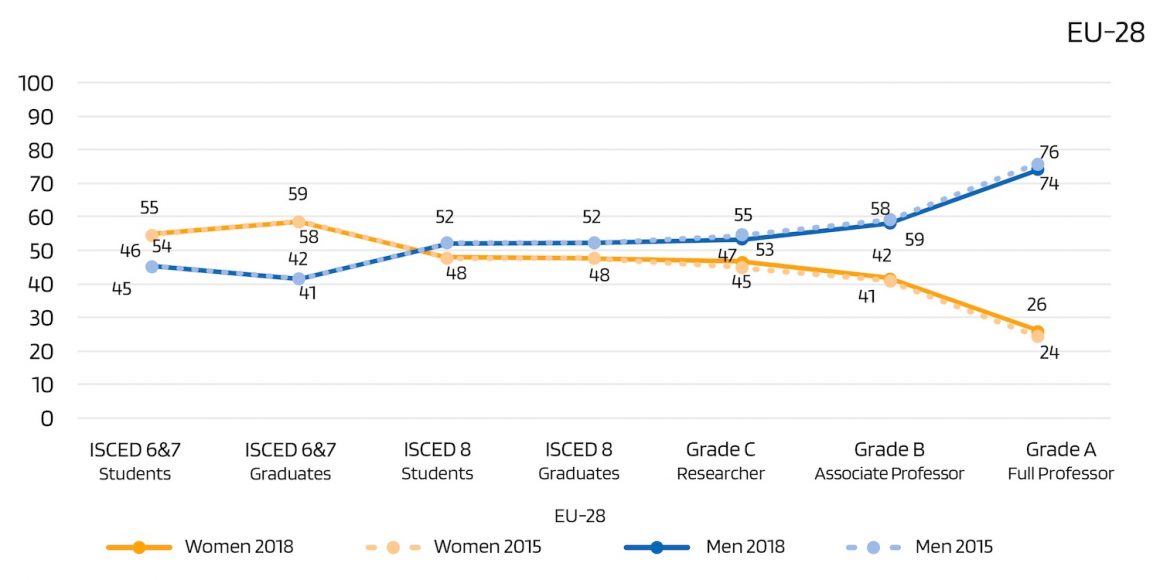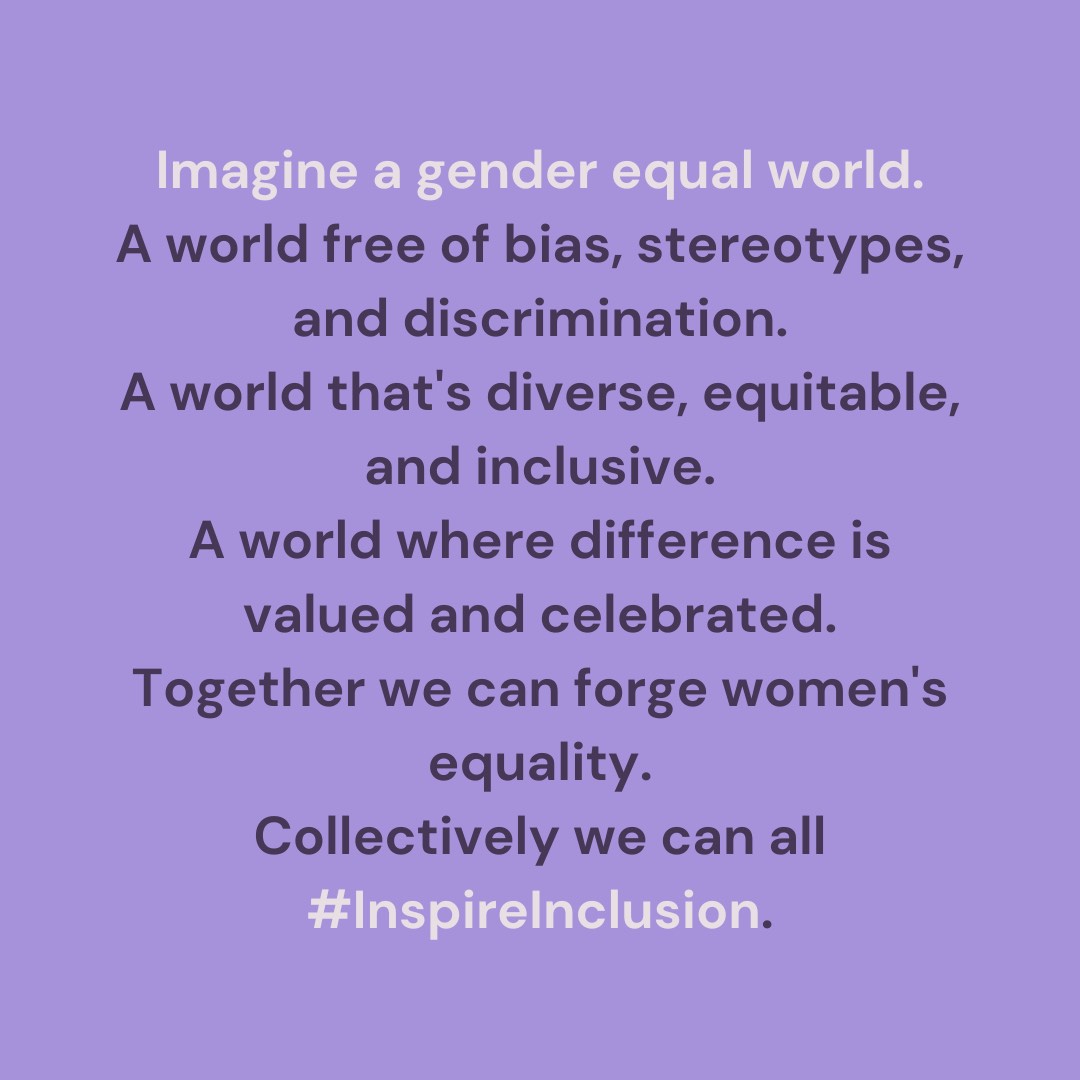Despite significant and hopefully promising discussions, graphs plotted using data from studies conducted at global and European levels continue to show a distinctive ‘scissors’ shape, indicating a significant gender gap in academic and scientific careers, which starts at the doctoral level, and widens from there on. In recent decades, the proportion of women among undergraduates has grown, so they are now the majority in many countries, including Italy. On average, female students are more dedicated, less likely to drop out, and graduate with higher grades. The crucial pivot point of the scissors, where numbers of women and men achieve a level of parity, corresponds to the period of PhD research.
Gender disparities are minimal when it comes to the first job and the first salary, although this can vary by sector. It is around five years into their careers that the blades of the scissors begin to widen more emphatically in favour of men. The reasons are multiple, ranging from pregnancy and childbirth leading to reorganisation of time and energy, to the type and number of new duties and assignments, economic considerations, stability of employment, and deeply rooted cultural discrimination.

Source: European Commission, Directorate-General for Research and Innovation, She figures 2021, Fig 6.1. Original data from Women in Science database, DG Research and Innovation – T1_questionnaires, Education Statistics (online data codes: educ_uoe_enrt03, educ_uoe_grad02)
ISCED – International Standard Classification of Education; ISCED 6 – Bachelor’s degree or equivalent; ISCED 7 Master’s or equivalent; ISCED 8 – Doctorate or equivalent
The glass ceiling
This intertwining of causes is known as the ‘glass ceiling’ – an invisible yet tangible barrier that hinders women from reaching leadership positions and equal success in their professional careers, despite equal qualifications and competencies. The glass ceiling can prevent women from accessing manager positions in sectors traditionally dominated by men, such as politics, business, scientific research and medical departments.
The Reykjavík Index for Leadership, measuring the perception of equality between women and men in leadership since 2018, has found that in the G7 countries there has been no measurable progress in the perception of women in positions of power over the last five years. It finds that women are only slightly less prejudiced than men regarding whether women are suited to leadership. Of particular concern is the finding that young people exhibit stronger biases than their parents. This is a trend that needs close monitoring, and is indicative of the fragmentation of traditional media and the impact of online misogynistic material viewed by young people, which over time could undermine gender equality.
According to the 2023 Gender Social Norms Index, published by the United Nations Development Programme and covering 85% of the world’s population, almost half of those sampled believe that men make better political leaders than women, and two in five think that men are more capable business executives than women.
In the choice of university courses, girls tend to show a preference for humanities or social sciences over science, technology, engineering, and mathematics (STEM disciplines). The gender imbalance is particularly evident in engineering and ICT (information and communication technologies), with women constituting less than 30% and less than 15% of enrolments, respectively.
This phenomenon is influenced by cultural, social, and educational factors. Traditional gender roles and cultural stereotypes can influence the expectations of girls and their families regarding educational and professional choices. Consciously or unconsciously, parents can shape the development of their children from a very young age: for example, by establishing a more physical relationship with boys and a more discursive one with girls. Scientific toys tend to be gifted to boys rather than girls. STEM disciplines are often perceived as ‘masculine’ – except for some scientific subjects related to caregiving, such as nursing – while humanities are seen as more ‘appropriate’ for girls.
The dream gap
The term ‘dream gap’ refers to the disparity between a girl’s ambitions and potential and the limitations, perceived or imposed by society, which influence her self-esteem, goals, and perceptions of available opportunities. The presence of female role models can be a crucial inspirational factor, as well as a source of fascination and encouragement.
Released in 2016, the film Hidden Figures had a significant impact on girls’ career choices, especially in the fields of science, technology, engineering. Based on the true story of three African American mathematicians who played crucial roles at NASA during the early years of the US space programme, it inspired girls by showcasing strong and extraordinarily talented female protagonists succeeding in mathematical roles, overcoming prejudices and discriminations. It demonstrated that women can excel in fields traditionally dominated by men, breaking stereotypes and instilling confidence.
The film also raised awareness about the significant contributions women have made to science and engineering. Since its release, the work of many other female mathematicians and engineers, such as those working at London’s Greenwich Observatory in the late 19th century, have been rediscovered. Seeing characters with whom girls can identify may encourage them to envision careers in STEM. This cultural narration emphasises the importance of education and perseverance in pursuing one’s dreams, conveying the message that, with determination and hard work, anyone can overcome obstacles and achieve their goals. It can also inspire parents and educators to encourage girls to study STEM subjects, and provide them with the necessary support and resources.
The film Hidden figures demonstrated that women can excel in fields dominated by men, breaking stereotypes and instilling confidence
Taking an example from written biographies, the renowned Nobel Prize-winning scientist Rita Levi Montalcini wrote a book titled Le tue antenate (Your female ancestors), published posthumously in 2017. The book tells young readers the stories of seventy women who made fundamental contributions to science, even during historically patriarchal periods such as Antiquity and the Middle Ages. It presents a parade of women who succeeded in the face difficulties and tragedies, driven by an unwavering passion for discovery, while also raising children – sometimes many – and often instilling in them a love of knowledge.
Montalcini also used to emphasise that the most important quality of a scientist is not genius but curiosity. Other fundamental qualities include precision, critical thinking, creativity, communication, collaboration, patience, determination, and integrity – none of which are exclusive to men.
Inspire inclusion
The theme for International Women’s Day 2024 is to ‘Inspire inclusion’.
“When we inspire others to understand and value women’s inclusion, we forge a better world.
“And when women themselves are inspired to be included, there’s a sense of belonging, relevance, and empowerment.
“Collectively, let’s forge a more inclusive world for women.”
The sticky floor
It is important to encourage girls to pursue careers in STEM fields. Medicine and oncology will progressively rely more on physics, chemistry, informatics, and engineering, which are the pillars of STEM disciplines. Gender diversity in this and other sectors fosters more innovative and comprehensive solutions. Women bring unique and diverse perspectives to solving scientific and technological problems, contributing to progress towards gender equality. However, it is also crucial for women to continue advancing in scientific careers, taking on more prominent roles, breaking through the glass ceiling, and reaching top positions.
To achieve this, it is essential to also understand and address the phenomenon of the ‘sticky floor’ – a condition that keeps women stuck in lower ranks, preventing them from reaching even middle-management levels. In addition to the challenges posed by motherhood, which adversely affects women’s careers at multiple levels and should be addressed radically on legislative and social fronts, there are gender discriminations present in the workplace. There is also a ‘confidence gap,’ where women often undervalue their own skills, influencing the types of job applications, assignments, and scholarships they pursue, as well as how they present their abilities. In contrast, men tend to emphasise their experiences and qualities, being more assertive in job searches.
While parenthood may lead some women to put their careers on hold, reducing the search for new jobs or their working hours, it has the opposite effect on men. Often, fathers work longer hours than colleagues without children, and seek promotions with greater determination. Remaining in lower-paying jobs for an extended period also influences subsequent salaries, calculated by employers based on the current pay.
Often, fathers work longer hours than colleagues without children, and seek promotions with greater determination
A potential ‘vicious circle’ is the very low presence of girls in computer science and engineering studies. In an era where algorithms increasingly influence and determine choices, and artificial intelligence is trained to perform more tasks, the lack of female input can lead to gender biases, often unconscious, which is also disadvantageous in the field of recruitment. Major companies such as Amazon and LinkedIn noticed this issue years ago, and had to withdraw and rewrite algorithms used for candidate filtering due to biased outcomes against women.
Apart from addressing overt workplace aggressions and micro-aggressions against women, there are also unconscious biases, implicit associations that are elusive and challenging to eradicate. Only with a higher female presence in the computer science and communication sector can we hope to create more objective deep learning.
Although supporting young female researchers is essential to reduce gender bias, the academic system continues to lose women at a higher rate in all stages of their careers. Consequently, focusing only on junior researchers may not be sufficient. Receiving fewer rewards, often lower salaries, and having fewer career advancements, women withdraw from the workforce sooner, either through early dropouts or early retirements. The cumulative effect of this trend exacerbates the gender disparity among senior mentors, contributing to maintaining the cycle of lower retention and advancement of female scientists.
Receiving fewer rewards, often lower salaries, and having fewer career advancements, women withdraw from the workforce sooner
A study conducted by the group led by Junming Huang used the reconstruction of researchers’ academic careers to confirm substantial differences in productivity and impact between female and male scientists in various disciplines and countries, starting from 1955. The study indicates that the gradual increase in the presence of women in STEM disciplines did not resolve the gender disparities in terms of impact. This does not seem to be due to a difference in the pace of publications, which are overall very similar, but rather to variations in the length of women’s academic careers and higher rates of female dropout.
While the observed numerical fluctuations in statistics need to be studied and monitored, it is challenging to identify a precise trend in the progression of women in science in recent years. Over a broader time span, achievements in this sector are distinctly visible. For example, only 10 women received Nobel Prizes in science in the first 100 years (1902–2001), compared to the five who have received them from 2004 to the present (2023). Specifically, from the beginning until 2023, women have received 13 prizes for Physiology or Medicine, eight for Chemistry, and only five for Physics. Signed by UN members in 2015, the Sustainable Development Agenda set gender equality by 2030 among its goals. We are now halfway to 2030, but unfortunately projections have shifted toward a more distant future.
The crisis caused by Covid-19, the subsequent ‘new normal’ of hybrid work, and the high exodus, forced or voluntary, of women from the workforce, along with environmental emergencies, and growing economic and political insecurity, are exacerbating challenges in the journey toward gender equality. Health, climate, humanitarian and social crises have increased the incidence of physical and verbal assaults, sexual violence, and, not least, homicides experienced by women.
A backlash against long-established women’s rights and online communication-related hate speech damage independence and weaken women’s trust in society and themselves. Paradoxically, this sense of insecurity leads them to turn to male leaders, considered ‘historically’ more capable of solving challenging political and economic situations, because patriarchal values are still firmly woven into the fabric of our culture. Only when the presence of women under the spotlight is considered the norm rather than an exception can we focus on the value of individuals, respecting the diversity that is the foundation of innovation.
Nations that promote women’s participation in STEM often improve their global economic and technological competitiveness
Top women’s associations in their fields are crucial practical reference points and provide role models that are particularly important at this moment to overcome the decline and regain confidence on the path to gender equality. A passion for science and the satisfaction of discoveries, supported by an encouraging environment, not only contributes to scientific progress but also opens up more interesting economic opportunities and potentially more solid careers. Furthermore, nations that promote women’s participation in STEM often improve their global economic and technological competitiveness. Developing the potential of women in STEM sectors can contribute to the economic growth and innovation of an entire country.
h-index
In the scientific and academic field, the use of bibliometric indicators is a fundamental criterion for allocating research funding and advancing researchers’ careers. The h-index, an abbreviation for the ‘Hirsch index,’ is the most widely used metric for quantifying the quality and relevance of an individual’s academic publications. Proposed by theoretical physicist Jorge E. Hirsch in 2005, the h-index takes into account both the number of scientific papers published by a researcher and the number of citations received by these papers. A researcher has an h-index of ‘n’ if they have published ‘n’ papers that have been cited at least ‘n’ times each.
Reaching a high h-index (above 50) can be more challenging for women than men, for a number of reasons. The index takes into account accumulated citations over time, which means that a researcher with a longer career generally has a higher h-index than one with a shorter career, even if the latter may have had a significant impact in a shorter period. Often it does not distinguish between lead authors and co-authors, so it can be influenced by collaborations with other researchers, especially in research fields where papers tend to be authored by teams of scientists. Lastly, some publications may receive many citations because they have been criticised, not necessarily because they have been accepted or deemed influential.
For fair representation in competitions, as suggested for example by Giovanni Abramo, an intervention with an immediate impact to compensate for women’s contextual disadvantage could be to apply scientific performance measures that differentiate between genders.
Visibility
Visibility (at meetings, in the media etc) is also of great value, both as encouragement for the careers of other women and for one’s own, as it opens up new communication avenues and showcases one’s work. Women experts exist and should be consulted more often by the media. The #equalpanel Manifesto, developed by the European Women’s Management Development Network, consists of 10 guidelines or ethical commitments in organising speaker panels, and aims to invite companies, institutions, associations, and public administrations to adhere to a pact for gender equality in conference panels, seminars, and events.
Participating in interviews, panels, and engaging on social media are all elements that open up dialogue, promote women’s research, and foster future collaborations.

With the collaboration of Francesca Albini and William Russell-Edu
* This article is a redacted and translated version of ‘The progression of women in scientific careers: critical issues, barriers and solutions’, by Adriana Albini, published in in Verso un’equità di genere nella salute e nella ricerca [Towards gender equity in health and scientific research], a 2023 White Paper by the Italian National Observatory on Women’s and Gender Health (chapter 4.3). It is republished here by kind permission of the Italian National Observatory on Women’s and Gender Health












